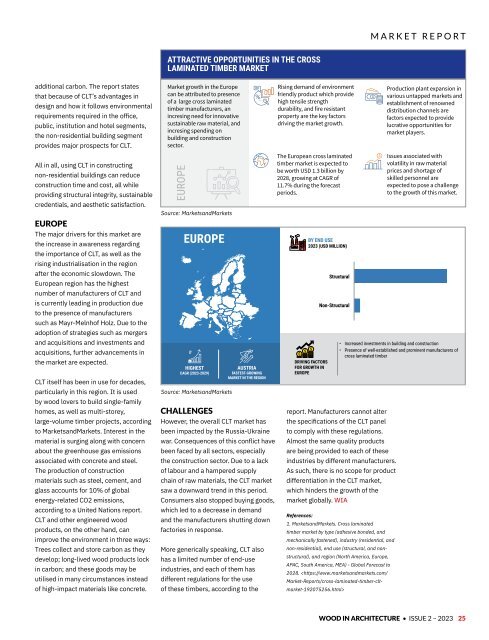WIA_ISSUE2_2023
Create successful ePaper yourself
Turn your PDF publications into a flip-book with our unique Google optimized e-Paper software.
ATTRACTIVE OPPORTUNITIES IN THE CROSS<br />
ATTRACTIVE LAMINATED TIMBER OPPORTUNITIES MARKET IN THE CROSS<br />
LAMINATED TIMBER MARKET<br />
MARKET REPORT<br />
additional carbon. The report states<br />
that because of CLT’s advantages in<br />
design and how it follows environmental<br />
requirements required in the office,<br />
public, institution and hotel segments,<br />
the non-residential building segment<br />
provides major prospects for CLT.<br />
All in all, using CLT in constructing<br />
non-residential buildings can reduce<br />
construction time and cost, all while<br />
providing structural integrity, sustainable<br />
credentials, and aesthetic satisfaction.<br />
EUROPE<br />
The major drivers for this market are<br />
the increase in awareness regarding<br />
the importance of CLT, as well as the<br />
rising industrialisation in the region<br />
after the economic slowdown. The<br />
European region has the highest<br />
number of manufacturers of CLT and<br />
is currently leading in production due<br />
to the presence of manufacturers<br />
such as Mayr-Melnhof Holz. Due to the<br />
adoption of strategies such as mergers<br />
and acquisitions and investments and<br />
acquisitions, further advancements in<br />
the market are expected.<br />
CLT itself has been in use for decades,<br />
particularly in this region. It is used<br />
by wood lovers to build single-family<br />
homes, as well as multi-storey,<br />
large-volume timber projects, according<br />
to MarketsandMarkets. Interest in the<br />
material is surging along with concern<br />
about the greenhouse gas emissions<br />
associated with concrete and steel.<br />
The production of construction<br />
materials such as steel, cement, and<br />
glass accounts for 10% of global<br />
energy-related CO2 emissions,<br />
according to a United Nations report.<br />
CLT and other engineered wood<br />
products, on the other hand, can<br />
improve the environment in three ways:<br />
Trees collect and store carbon as they<br />
develop; long-lived wood products lock<br />
in carbon; and these goods may be<br />
utilised in many circumstances instead<br />
of high-impact materials like concrete.<br />
<br />
<br />
<br />
<br />
<br />
<br />
<br />
<br />
<br />
<br />
<br />
<br />
<br />
<br />
<br />
<br />
<br />
<br />
EUROPE<br />
Source: MarketsandMarkets<br />
EUROPE<br />
HIGHEST<br />
CAGR (<strong>2023</strong>-2029)<br />
Source: MarketsandMarkets<br />
AUSTRIA<br />
FASTEST-GROWING<br />
MARKET IN THE REGION<br />
CHALLENGES<br />
However, the overall CLT market has<br />
been impacted by the Russia-Ukraine<br />
war. Consequences of this conflict have<br />
been faced by all sectors, especially<br />
the construction sector. Due to a lack<br />
of labour and a hampered supply<br />
chain of raw materials, the CLT market<br />
saw a downward trend in this period.<br />
Consumers also stopped buying goods,<br />
which led to a decrease in demand<br />
and the manufacturers shutting down<br />
factories in response.<br />
More generically speaking, CLT also<br />
has a limited number of end-use<br />
industries, and each of them has<br />
different regulations for the use<br />
of these timbers, according to the<br />
<br />
<br />
<br />
<br />
<br />
<br />
<br />
<br />
<br />
<br />
<br />
<br />
<br />
<br />
<br />
<br />
<br />
<br />
<br />
<br />
<br />
<br />
<br />
<br />
BY END USE<br />
<strong>2023</strong> (USD MILLION)<br />
DRIVING FACTORS<br />
FOR GROWTH IN<br />
EUROPE<br />
Structural<br />
Non-Structural<br />
report. Manufacturers cannot alter<br />
the specifications of the CLT panel<br />
to comply with these regulations.<br />
Almost the same quality products<br />
are being provided to each of these<br />
<br />
<br />
<br />
<br />
<br />
<br />
<br />
<br />
<br />
<br />
<br />
<br />
<br />
<br />
<br />
<br />
<br />
<br />
<br />
<br />
<br />
<br />
<br />
<br />
<br />
<br />
• Increased investments in building and construction<br />
• Presence of well-established and prominent manufacturers of<br />
cross laminated timber<br />
industries by different manufacturers.<br />
As such, there is no scope for product<br />
differentiation in the CLT market,<br />
which hinders the growth of the<br />
market globally. <strong>WIA</strong><br />
References:<br />
1. MarketsandMarkets. Cross laminated<br />
timber market by type (adhesive bonded, and<br />
mechanically fastened), industry (residential, and<br />
non-residential), end use (structural, and nonstructural),<br />
and region (North America, Europe,<br />
APAC, South America, MEA) - Global Forecast to<br />
2028. <br />
WOOD IN ARCHITECTURE • ISSUE 2 – <strong>2023</strong> 25

















